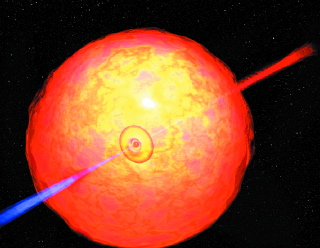Gamma ray bursts, sometimes called "God's fireworks", are actually quick but concentrated flashes of short-wavelength, high-energy radiation

Direct link to this page: https://www.hayadan.org.il/gamma0803.html
Gamma ray bursts, which are sometimes called "God's fireworks", are actually quick but concentrated flashes of short-wavelength, high-energy radiation.
Most astronomers agree that massive stars play a role in creating these spectacular events, but there is some debate about how this happens. Is it a collapse of
Are these stars into black holes that produce these explosions, or are they actually part of the remnants of supernova explosions? Either way, astronomers think that gamma-ray bursts can teach them about the deaths of large stars and even the birth of new stars.
Within 20 seconds, a significant burst of gamma rays emits more energy than the sun produces in its 10 billion years of life.
Gamma ray bursts detected by military satellites in 1967 were not reported in scientific journals until 1972.
When a star at least thirty times as massive as the Sun exhausts its nuclear fuel, gravity forces its core to collapse, and its outer shell explodes. According to one theory, Pizzo. The gamma ray occurs about ten years later, when the core collapses into a neutron star.
Two other possibilities are merging neutron stars and black hole activity. Some astronomers suggest the possibility that the explosion occurs when the hole engulfs its "torus," a wheel-shaped ring of gases and dust that spins around its circumference.
Scientists estimate that 100 gamma ray bursts occur in the visible universe every day. But near-Earth detectors can only see one or two of them.
The farthest explosion ever recorded began about 11 billion light-years away, when the universe was only a few billion years old. Astronomers have witnessed events that may have been even "older". However, they were unable to collect enough information in time to estimate the age of the explosions.
The shortest bursts last about 0.01 seconds and the longest bursts last up to 15 rakats. Most of them fade after 20 seconds. Since they are so short, the biggest challenge posed by gamma ray bursts is locating the source of the burst.
Optical radiation glows for 24 hours, giving astronomers only one day to look for visual clues to the source of the radiation. In the past this time was not enough, as it was difficult to gain access to the observatory at such short notice. With and, the new observatory, "Swift", should solve this problem. Swift, due to open in September 2003, will be the first observatory dedicated to the study of gamma-ray bursts, removing the need for last-minute searches for telescope time. Swift's detector should lock onto another burst or two a week, giving astronomers much more data to work with, and also less likely to lose track of the bursts, a fixed telescope will lock onto the potential source before the optical radiation decays.
NASA recently signed a 107 million roller contract for GLAST. A space telescope, with the "Astro Spectrum", centered in Gilbert, Arizona. GLAST will be 30 times more sensitive than its predecessor, Compton, and should expand that satellite's survey of the sky in the gamma-ray region, capturing and mapping even more distant explosions. The GLAST should be launched in 2006.
Gamma rays are also useful on Earth. Short wavelengths allow the rays to penetrate any normal material, making them excellent scanning devices. Unfortunately, the high-energy rays can damage DNA, so gamma ray devices are not often used.
https://www.hayadan.org.il/BuildaGate4/general2/data_card.php?Cat=~~~604497087~~~60&SiteName=hayadan
